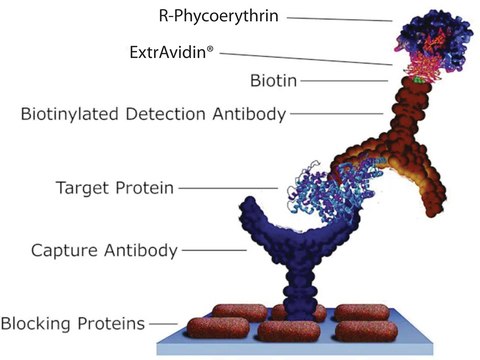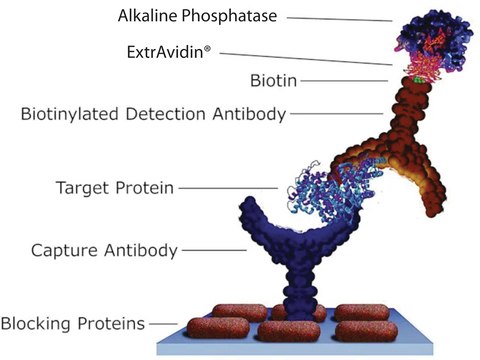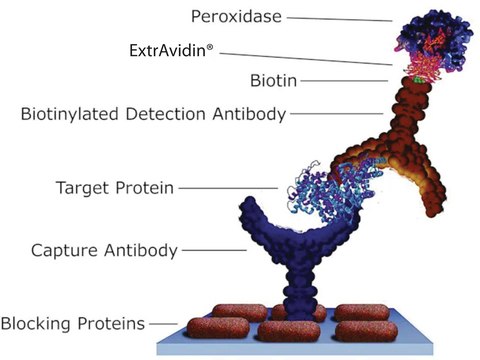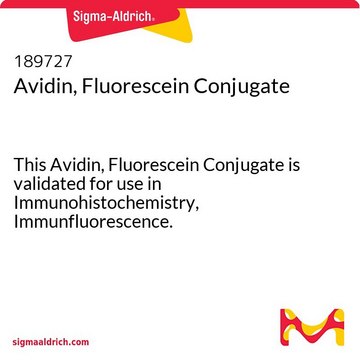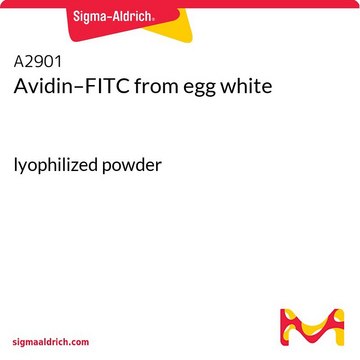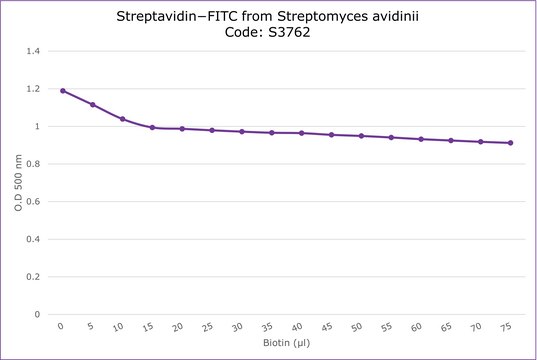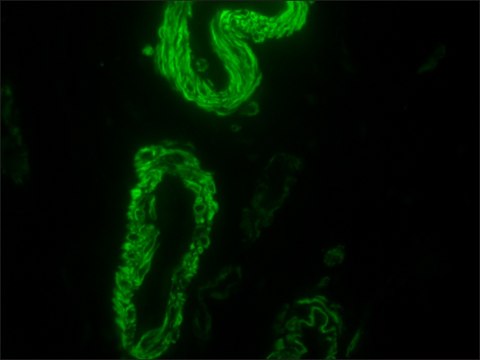Recommended Products
conjugate
FITC conjugate
Quality Level
form
buffered aqueous solution
extent of labeling
3-6 mol fluorochrome per mol protein
technique(s)
immunohistochemistry (formalin-fixed, paraffin-embedded sections): 20 μg/mL using human tissues
indirect immunofluorescence: 1:200
shipped in
dry ice
storage temp.
−20°C
General description
Avidin is a tetrameric or dimeric biotin-binding protein produced in the oviducts of birds, reptiles and amphibians and deposited in the whites of their eggs. It consists of four high affinity binding sites for biotin. ExtrAvidin is prepared from egg white avidin. It is a modified form of affinity purified avidin and combines high specific activity of avidin with the low background staining of streptavidin. It is a biotin binding protein produced by the bacteria Streptomyces avidinii. ExtrAvidin has been conjugated to fluorescein isothiocyanate (FITC) and is used for various techniques.
Application
ExtrAvidin®-FITC is suitable for the following applications:
- immunohistochemistry (formalin-fixed, paraffin-embedded sections) at a concentration of 20μg/mL using human tissues.
- Immunofluorescence†
- competitive binding assay
Physical form
Solution in 0.01 M phosphate buffered saline, containing 10% (v/v) 0.5 M carbonate buffer, pH 9.5, and 15 mM sodium azide
Preparation Note
Affinity purified protein
Legal Information
ExtrAvidin is a registered trademark of Merck KGaA, Darmstadt, Germany
Disclaimer
Unless otherwise stated in our catalog or other company documentation accompanying the product(s), our products are intended for research use only and are not to be used for any other purpose, which includes but is not limited to, unauthorized commercial uses, in vitro diagnostic uses, ex vivo or in vivo therapeutic uses or any type of consumption or application to humans or animals.
Storage Class Code
12 - Non Combustible Liquids
WGK
WGK 2
Flash Point(F)
Not applicable
Flash Point(C)
Not applicable
Regulatory Information
动植物源性产品
Choose from one of the most recent versions:
Certificates of Analysis (COA)
Lot/Batch Number
Don't see the Right Version?
If you require a particular version, you can look up a specific certificate by the Lot or Batch number.
Already Own This Product?
Find documentation for the products that you have recently purchased in the Document Library.
Xueying Wang et al.
eLife, 3, e03427-e03427 (2014-07-17)
To understand the neural origins of rhythmic behavior one must characterize the central pattern generator circuit and quantify the population size needed to sustain functionality. Breathing-related interneurons of the brainstem pre-Bötzinger complex (preBötC) that putatively comprise the core respiratory rhythm
Therapeutic monoclonal antibodies for Ebola virus infection derived from vaccinated humans
Rijal P, et al.
Cell Reports, 27, 172-186 (2019)
Expression and localization of urokinase-type plasminogen activator receptor in bovine cumulus--oocyte complexes
Garcia DC
Zygote, 24, 230-235 (2016)
Maria Cristina D Picardo et al.
The Journal of physiology, 591(10), 2687-2703 (2013-03-06)
Breathing in mammals depends on an inspiratory-related rhythm that is generated by glutamatergic neurons in the pre-Bötzinger complex (preBötC) of the lower brainstem. A substantial subset of putative rhythm-generating preBötC neurons derive from a single genetic line that expresses the
D R Hampson et al.
The Journal of biological chemistry, 274(47), 33488-33495 (1999-11-24)
Metabotropic glutamate receptors (mGluRs) are G-protein-coupled glutamate receptors that subserve a number of diverse functions in the central nervous system. The large extracellular amino-terminal domains (ATDs) of mGluRs are homologous to the periplasmic binding proteins in bacteria. In this study
Our team of scientists has experience in all areas of research including Life Science, Material Science, Chemical Synthesis, Chromatography, Analytical and many others.
Contact Technical Service